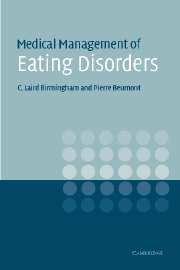Book contents
- Frontmatter
- Contents
- List of color plates
- List of contributors
- List of abbreviations
- Introduction
- PART I THE MEDICAL PERSPECTIVE
- PART II TREATMENT
- PART III SPECIAL ISSUES
- 8 Specific patient populations
- 9 Prepubertal children and younger adolescents
- PART IV THE PSYCHIATRIC AND PSYCHOLOGICAL PERSPECTIVE
- PART V AREAS OF SPECIAL INTEREST
- Bibliography
- Index
- Plate section
8 - Specific patient populations
Published online by Cambridge University Press: 18 December 2009
- Frontmatter
- Contents
- List of color plates
- List of contributors
- List of abbreviations
- Introduction
- PART I THE MEDICAL PERSPECTIVE
- PART II TREATMENT
- PART III SPECIAL ISSUES
- 8 Specific patient populations
- 9 Prepubertal children and younger adolescents
- PART IV THE PSYCHIATRIC AND PSYCHOLOGICAL PERSPECTIVE
- PART V AREAS OF SPECIAL INTEREST
- Bibliography
- Index
- Plate section
Summary
Managing the chronic patient
Case
Cindy was a 40-year-old female with AN who I followed for 20 years, until her death. She had severe, unremitting, restrictive AN complicated by hyponatremia, hypokalemia, hypomagnesemia, an empyema of her lung, multiple bone fractures, renal failure, anemia, and, terminally, pneumonia and acute inferior myocardial infarction. Cindy had been admitted repeatedly over the years to various eating disorder units. She had tried and given up on many psychiatrists and psychologists, she was on chronic disability leave from her work, and within the last few years of her life she moved to an apartment in a suburb where she would eat very small amounts of food and have intermittent infusions of saline, potassium, and magnesium at home. Cindy had been emaciated for years, but she enjoyed helping others and always asked me about my children and would send them birthday presents. Although she could hardly hobble around with the use of a cane, she dressed in vividly colored glasses and maintained her dignity to the end.
Comment
Treatment of patients with chronic AN is widely misunderstood. As in many illnesses, the rate of recovery is variable. The average patient with AN may have the disorder for a few years, but many patients will continue to be anorexic for many years and some for life. Many physicians become confused when it appears that treatment does not work, then adopting a palliative care approach to the treatment of patients with “chronic” AN.
- Type
- Chapter
- Information
- Medical Management of Eating DisordersA Practical Handbook for Healthcare Professionals, pp. 173 - 183Publisher: Cambridge University PressPrint publication year: 2004



